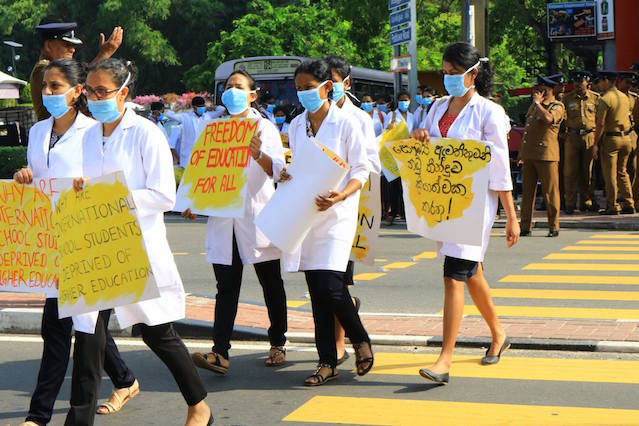SAITM Controversy & Making Of The Middle Class Medical Professional: Net Loss To Sri Lanka!

By Siri Gamage –March 26, 2017
In my article on class domination in Sri Lanka, I identified two segments of the Sri Lankan Middle Class, i.e. English speaking vs. Sinhala speaking (we could easily add Tamil speaking also to the latter). In this paper, I argue that the SAITM controversy not only reflects this division, competing interests and discourses (language forms used for expression) but also the aspiration of the Sinhala speaking (or Tamil speaking) parents to educate their children and move their class status from Sinhala or Tamil speaking segment to the English speaking segment against many odds. This is a broader trend that is not limited to parents of these children who work hard for their medical education through public or private universities. It is a trend one can observe when it comes to the children of university academics, other professionals, journalists, artists also. Moreover, the same trend can be observed among the children of politicians, government bureaucrats, private sector managers, and technocrats also.
This trend has its roots in the colonial impositions on the Ceylonese/Sri Lankan society where the learning of English language and learning other subjects through English were considered superior to learning Sinhala or Tamil and learning through these mother languages based on the ‘dominant modernist paradigm’ and its assumptions[1]. This trend which is rooted in Sri Lankan middle class psyche has far reaching implications for the education sector, Sri Lankan identity, loyalty to the country and diaspora living (via bifurcation of identity), family structures and parent-children relations, as well as the net economic gain or loss depending on the host and home country divide. I elaborate this argument further in the following pages.

It is a well-known fact that ‘modernist education’, in particular (free) higher education, produces and reproduces the middle class professionals out of various cohorts of young people who come to education institutions from a diversity of backgrounds with specific values, norms, outlook, perspectives and a worldview[2]. These backgrounds can be as divergent as ethnic, caste, class, language, religious, and locality. Thus students who grow up in far away rural locations or born to parents of average income and wealth ‘succeed’ in their educational pursuits due to sheer commitment, hardwork, encouragement by parents, and sacrifices in personal life. They navigate complex academic and bureaucratic schooling and higher education systems and processes –sometimes manipulated by those academic and bureaucratic elites who make policies and decisions in these respective fields- during their learning years while trying to follow the norms and standards set by their superiors and teachers-supervisors or gate keepers. Given the highly hierarchical nature of Sri Lankan society, higher education is one avenue available for members of the deprived classes to aspire to be a middle class professional. Established parties preserve politics for the kith and kin of the established political families with access to money and recognition. Doing business requires capital, knowhow and networks.

